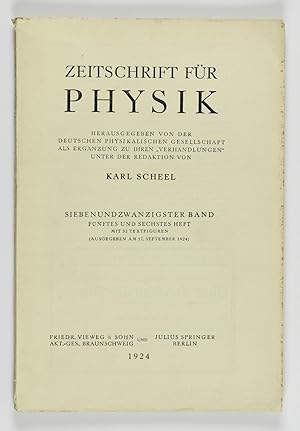einstein bose (2 Ergebnisse)
Produktart
- Alle Produktarten
- Bücher (2)
- Magazine & Zeitschriften
- Comics
- Noten
- Kunst, Grafik & Poster
- Fotografien
- Karten
-
Manuskripte &
Papierantiquitäten
Zustand
- Alle
- Neu
- Antiquarisch/Gebraucht
Einband
Weitere Eigenschaften
- Erstausgabe
- Signiert
- Schutzumschlag
- Angebotsfoto (1)
Land des Verkäufers
Verkäuferbewertung
-
Berlin, Springer, 1924. 8vo. Bound in contemporary half cloth. In "Zeitschrift für Physik", Bd. 27. Entire volume offered. Stamp to front free end paper. Fine and clean. [Einstein:] Pp. 1-6" P. 392. [Bose:] P. 392. [Entire volume: IV, 395, (1) pp]. First appearance of Einstein's paper on statistical mechanics and the physics of radiometers. Weil 139, 143a.
-
Wärmegleichgewicht im Strahlungsfeld bei Anwesenheit von Materie.
Anbieter: Antiquariaat Schierenberg, Amsterdam, Niederlande
Braunschweig, Friedrich Vierweg & Sohn; Berlin, J. Springer, 1924. 8vo (22.8 x 15.4 cm). 10 pp. Original printed wrappers. = First paper by the Indian physicist Satyendra Nath Bose (1894-1974) on thermal equilibrium in the radiation field in the presence of matter, and second paper sent to Albert Einstein with the request to translate and publish it in a German physics journal. Einstein saw the importance of the paper, but he disagreed with its contents and decided to add a lengthy comment. Subsequently Bose saw a way to circumvent Einstein's critique, but never published this rebuttal. Nearly 50 years later, Bose stated that he was disappointed by Einstein's remarks ".Bose had his own approach to quantum theory based on his views about the interconnectedness of spontaneous and induced emissions, which formed the subject matter of his second and third papers. He did not agree with Einstein's proposal to treat them as independent physical processes. Stationary states in atoms have zero widths both in the old and the new quantum theories and therefore have infinite life-times whereas in reality they do decay and jump down to lower energy states with a finite life-time. What is the origin of these finite widths? In Bose's view, they are the consequence of the interaction between atom and environment, as he attempted to show in his second and third papers. But Einstein did not agree and dismissed his views with the remark that in a world consisting of a single excited hydrogen atom and nothing else, the atom would obviously emit a photon and come down to its ground-state! Einstein did not explain what would excite an atom in such a world. Bose was very disappointed by this simply because the world does have much more than a single hydrogen atom, and inevitably every atom has an environment" (Wali). Contained in: Zeitschrift für Physik, volume 27(5-6). The complete issue, in its original wrappers. Upper right corner somewhat bumped throughout. Rear wrapper slightly frayed at edges; minimal spotting at the fore and bottom edges. Volume number written on spine; otherwise a very good, clean copy. Wali, K. C. (2009). Satyendra Nath Bose: His Life and Times: Selected Works (with Commentary), p. xxvi.



